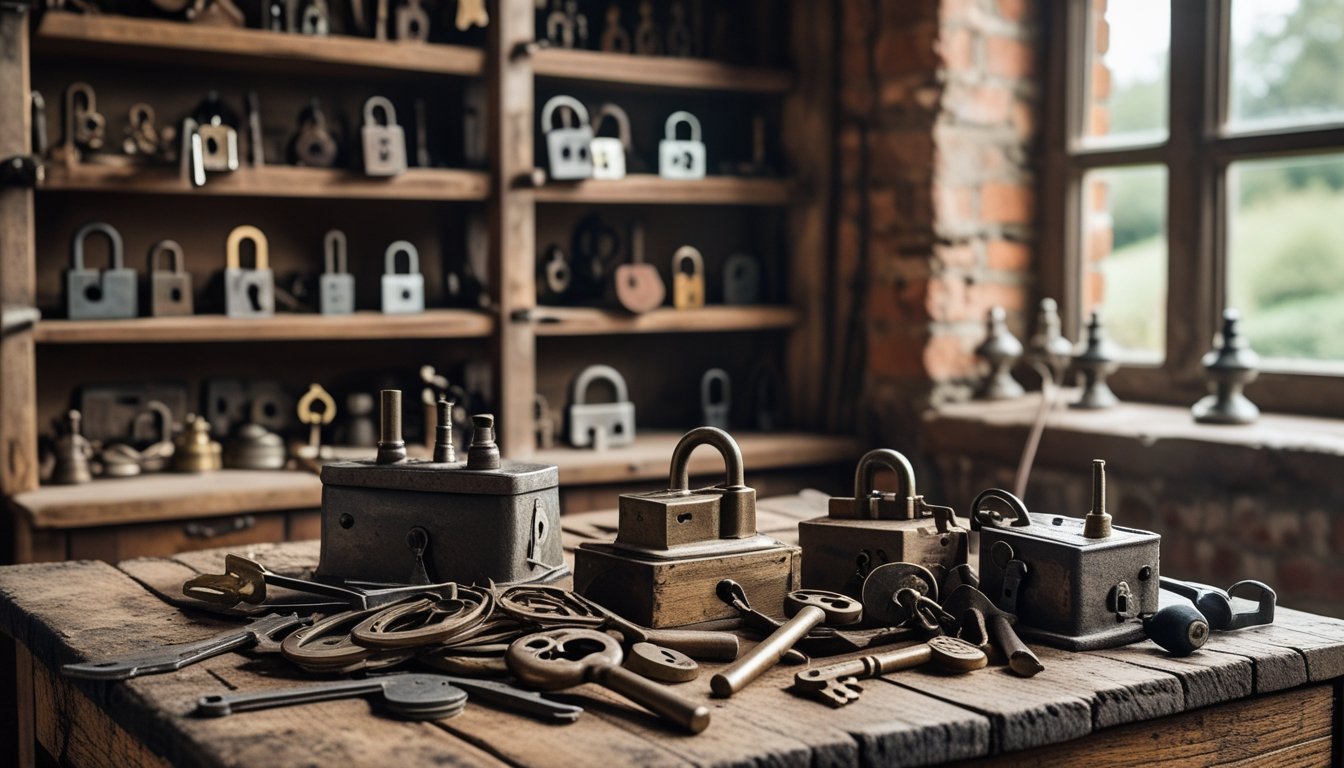Late updated: 28 Nov 2025 09:11
Written by: Elena Prescott
Exploring The History Of Locksmithing In The UK: A Journey Through Time
The history of locksmithing in the United Kingdom is a captivating tapestry woven through centuries, marked by technological evolution, craftsmanship, and the ever-present need for security. From the rudimentary wooden mechanisms of ancient times to today's sophisticated digital security systems, locksmithing has constantly adapted to the changing needs and challenges of society. This rich historical narrative invites us to consider not only how locks have evolved, but also how they've influenced the way we live and secure our belongings.

As we explore this journey, we uncover a profession that has remained crucial through the ages, evolving alongside innovations in metalwork and mechanics. The UK's legacy of locksmithing skill is evident in the intricate designs and efficient mechanisms that locksmiths have developed over the years. With its roots traced back to ancient Egyptian techniques, the practice of locksmithing has not only secured empires but has also become a vital part of our daily lives.
Today, UK locksmiths continue to play a pivotal role in keeping our homes and businesses safe, integrating traditional methods with cutting-edge technology. As we delve deeper into this fascinating history, we reveal the stories behind the craft that have shaped it into what it is today.
Key Takeaways
- Locksmithing has evolved from ancient wooden locks to modern digital systems.
- The trade has adapted to technological, social, and economic changes over centuries.
- Today's UK locksmiths integrate traditional methods with new technology.
Key Milestones in the Evolution of Locksmithing in the UK

Locksmithing in the UK has a rich history, marked by critical innovations such as the development of metal and ornate locks, and pioneering designs like the double-acting tumbler lock. These advancements helped shape modern security solutions.
Ancient and Medieval Locks in Britain
In ancient and medieval Britain, locksmithing began with simple yet functional constructions. The oldest known locks were made from wood, utilising basic mechanisms to secure property. While primitive, these wooden locks were efficient for their time. Later, with the Saxons and Normans, locksmithing evolved to include metal components, which increased durability. Intricate designs started emerging during the later medieval period, reflecting the evolving expertise of locksmiths of the era. These changes highlighted the increasing importance of not only security but also craftsmanship. The shift from purely functional to decorative locks marked a turning point in British locksmithing history.
The Transition from Wooden to Metal Locks
The transition from wooden to metal locks represented a significant milestone in UK locksmithing. With metal, locks became sturdier and more secure, resisting both the elements and tampering. Iron was the primary material used in this era, and by the 18th century, the introduction of brass and steel further improved the reliability of locks. The increased strength and security of metal locks revolutionised how people protected their possessions and marked a crucial advancement in the locksmith industry. This evolution mirrored broader technological changes, as locksmiths adapted to and capitalised on metalworking techniques to produce more robust and intricate locking mechanisms.
The Age of Ornate Locks and the Role of Locksmiths
As locksmithing techniques advanced, the age of ornate locks emerged, highlighting both functionality and artistic craftsmanship. Locksmiths embraced this opportunity to demonstrate their skills, often creating intricate and decorative exterior designs that served wealthy patrons. These elaborate locks became status symbols, signifying wealth and security sophistication. During this period, the role of locksmiths expanded beyond practical security solutions to include elements of art and personal expression. While these locks were ornate, their complex mechanisms also increased security, showcasing the dual focus on aesthetics and practicality in locksmithing during this time.
Pioneering British Innovations in Lock Mechanisms
British innovations have significantly shaped the history of lock mechanisms, with notable figures such as Robert Barron and Jeremiah Chubb leading the way. In 1778, Barron invented the double-acting tumbler lock, a design that laid the groundwork for more complex security devices. Chubb's 1818 invention, the detector lock, introduced the concept of detecting unauthorised attempts at tampering, revolutionising security. In the mid-19th century, Linus Yale developed the pin tumbler mechanism, securing his place in the annals of locksmithing. These inventions not only enhanced security but also influenced locksmithing worldwide. These ingenious designs underscored a period of dynamic evolution in the UK’s approach to lock security.
Modern Developments and the Role of UK Locksmiths Today
As we delve into the modern era, the locksmithing profession in the UK has evolved significantly, embracing cutting-edge technology and formalising industry standards. This evolution has changed how locksmiths operate, offering sophisticated security solutions and bolstering their professional standing.
From Mechanical to Electronic and Smart Locks
The transition from traditional mechanical locks to electronic and smart locks marks a significant shift in locksmithing practices. Modern locksmiths are adept at handling various advanced locking systems, including electronic card readers and biometric systems. Smart locks, connected through the Internet of Things (IoT), allow users to control entry to their premises via smartphones. These systems enhance convenience and security but require locksmiths to possess substantial technical knowledge. As technology advances, locksmiths continue to adapt, ensuring they can install, maintain, and troubleshoot these complex systems effectively. This adaptability keeps locksmiths integral in safeguarding homes and businesses with state-of-the-art security solutions.
The Professionalisation of Locksmiths and Industry Organisations
Over recent years, the locksmithing industry in the UK has seen a drive towards professionalisation. The Master Locksmiths Association (MLA) plays a pivotal role in this development, setting standards and offering comprehensive training and certification for locksmiths across the country. By adhering to these standards, locksmiths not only enhance their credibility but also build trust with their clients. Such professional recognition ensures that locksmiths are equipped with up-to-date skills and adhere to best practices. As locksmithing evolves, the importance of certification grows, requiring practitioners to continually update their skills and knowledge to meet rising security challenges.
Locksmith Expertise in Contemporary Security Systems
In today’s security landscape, locksmiths provide crucial expertise beyond traditional lock and key solutions. With the rise in residential and commercial security systems, locksmiths have expanded their repertoire to include alarm systems, safes, and security surveillance setups. Their ability to integrate and manage diverse systems is vital as security becomes ever more interconnected and sophisticated. Locked out scenarios require locksmiths to apply their skills quickly and efficiently, demonstrating their capability to handle emergencies with precision. Their expanding role underscores the need for an in-depth understanding of contemporary security trends and an ability to anticipate clients’ evolving needs, keeping locksmith services at the forefront of security innovation.
Frequently Asked Questions

The history of locksmithing in the UK is an intriguing tale of evolution and innovation. From ancient wood locks to modern smart systems, locksmiths have been at the forefront of security advancements.
What are the origins of locksmithing in the United Kingdom?
Locksmithing in the UK can be traced back to ancient times, with early evidence of wooden locks used in Britain. These primitive devices laid the foundation for more sophisticated metal locks that emerged in the mediaeval period.
How did the locksmith profession evolve during the Industrial Revolution?
The Industrial Revolution was a pivotal period for locksmiths in the UK. It transformed locksmithing from a small-scale craft into a mass-produced trade. Affordable locks became available to the wider public, leading to increased security for many households.
What were the major advancements in lock technology in British history?
One key advancement was the introduction of the lever tumbler lock in the 18th century. This innovation increased security and complexity, setting a benchmark for future developments. The evolution continued with the introduction of cylinder locks and eventually digital technology.
Can you describe the influence of famous British locksmiths on the trade?
Famous locksmiths such as Robert Barron and Jeremiah Chubb played significant roles in advancing the trade. Their inventions, including Barron's double-acting lever lock and Chubb's detector lock, were milestones that enhanced security and set new industry standards.
How has the role of locksmiths changed in the UK with the introduction of digital security measures?
Digital technology has expanded the role of locksmiths beyond traditional mechanical tasks. Locksmiths now deal with electronic access systems, smart locks, and other digital security solutions. This shift requires continuous learning and adaptation within the profession.
What are some of the most significant historical locks or keys preserved in the UK?
The Chubb detector lock is among the most notable historical locks, recognised for its security advancements. Historical collections also include various intricately designed keys and locks from different eras, showcasing the craftsmanship and technological innovations of their times.
